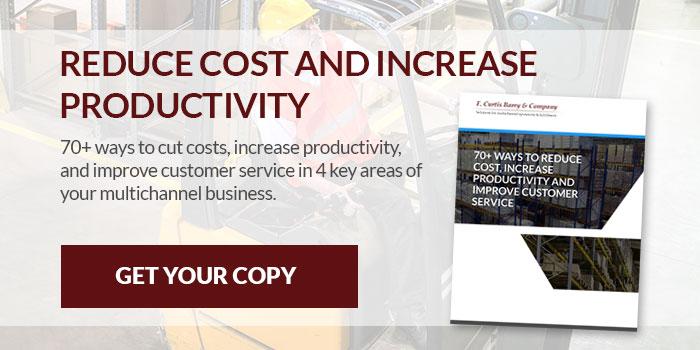When you consider the total cost of an order – management, direct and indirect labor, benefits, facilities, packing costs excluding shipping costs – more than 50% of the cost per order is labor related. Given this, do you measure productivity by department and individual? Looking at the e-commerce fulfillment operations we’ve done operational assessments for, more than half do not have accurate and consistent standards for productivity and measurements.
Without productivity measurement, how can you determine what changes in processes or automation will mean for your use of labor and the savings to be gained? Here are five considerations for improving your labor productivity.
1. Measure productivity and process
Ultimately you want to have productivity measures in all departmental areas. However, don’t try to measure everything at once. Where are you spending the most money? Tackle those one at a time. Recognize that you need to have methods and technology for recording time worked, including cross department functions and units of work (eg.. orders, units, cartons shipped). Picking and packing take more than 50% of the labor in most centers.
Picking
- Are you paying the more productive, error free worker considerably more? We often see pickers that pick at twice the rate of other pickers.
- Do you re-evaluate your SKU sales velocity several times per season to reduce costs? Slotting approaches with shortened pick distances for the better selling products cuts walk time way down.
Replenishment
- Replenishment is an example of a process that affects picking. Be sure replenishment is executed before order picking is started.
- If a picker goes to a slot and the product is not available, then the order is suspended. Someone must investigate to see why product is not available, and the slot must be filled and before picking is resumed.
Packing
- What governs the speed of packing in your operation?
- Is the design of the workstation efficient in terms of top size?
- Are inserts and sufficient storage available for cartons at each station?
- Can you justify automation such as envelope insertion, box building, etc.?
2. Increase work pace
How can you increase the work pace in the center? Once you start measuring, how can you reasonably raise the productivity goals?
One of the main benefits from applying technology and automation is that they increase the work pace dramatically, whether it’s voice picking, robotics or automation.
3. Manage today’s workload
- Are you managing the workload so that you process and ship all orders on the day of receipt? Or are you simply filling whatever orders you can fill by closing time (or a percent by a cut-off time)?
- Do you have the labor flexibility and ability to manage processing and shiping all orders on the day of receipt every day? Most centers should aim for making this a priority to meet customer’s expectation. Work to plan to fill all orders rather than the clock.
In some larger, well managed fulfillment facilities, we see monitors and system displays that tell the department managers and the employees how many orders are in their departments and how many need to be completed before the end of the shift.
4. Quality and availability of labor
As our economy inches toward full employment, what is the quality and the availability of the labor pool in your marketplace? In May 2018, the U.S. Bureau of Labor Statistics reported the national unemployment rate for non-farm workers edged downward again to 3.8 percent (compared to 4.3% in May 2017). In many distribution markets, the unemployment rate is below the national average. The May 2018 survey showed the labor force participation rate was unchanged at 62.7%.
What does it take to attract workers that have voluntarily stayed out of the workforce? Part of it is workers wanting full time instead of multiple part-time jobs with no benefits. But pay also factors in. In our small town on the coast of North Carolina, Hobby Lobby posts a recruitment poster at their store entrance for $15.75 plus good benefits for sales associates. In the same retail strip center, a newly renovated McDonald’s advertised $8.50 plus benefits. We advocate doing pay and benefit surveys regularly with other employers to be sure you are not losing ground. There can be stark differences.
5. Effective management
The most important aspect of getting more from your labor dollar is the quality and effectiveness of your key department leads and the fulfillment manager. Not only is their ability to manage people important, but they need to continually be on the lookout for ways to reduce costs and improve customer service.
The labor component to our warehouse expenses is key to providing a cost per order that makes our businesses cost competitive. At the same time we must be able to recruit qualified employees.






SHARE